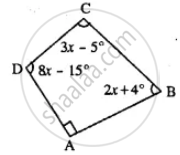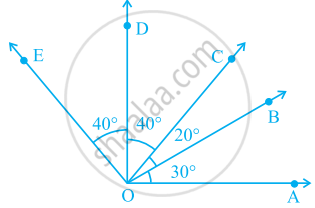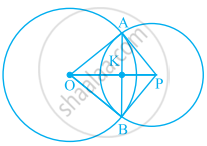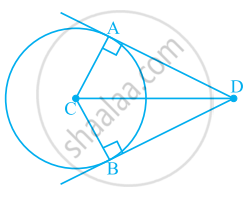Advertisements
Advertisements
प्रश्न
In ΔABC, E is the mid-point of median AD such that BE produced meets AC at F. IF AC = 10.5 cm, then AF =
पर्याय
3 cm
3.5 cm
2.5 cm
5 cm
उत्तर
ΔABC is given with E as the mid-point of median AD.

Also, BE produced meets AC at F.
We have AC = 10. 5cm , then we need to find AF.
Through D draw DK || BF.
In ΔADK, E is the mid-point of AD and EF || DK.
Using the converse of mid-point theorem, we get:
AF = FK…… (i)
In ,ΔBCFD is the mid-point of BC and BF || DK.
KC = FK…… (ii)
From (i) and (ii),we have:
AF = FK , AF = KC…… (iii)
Now,
AC = AF +FK + KC
AC = AF + FK + KC
From (iii) equation, we get:
AC = AF + AF + AF
AC = 3AF
` AF = 1/3 AC` …… (iv)
We have AC = 10.5cm .Putting this in equation (iv), we get:
`AF = 1/3(10.5cm)`
AF = 3.5cm
Hence the correct choice is (b).
APPEARS IN
संबंधित प्रश्न
How many diagonals does following have?
A regular hexagon
Determine the number of sides of a polygon whose exterior and interior angles are in the ratio 1 : 5.
Use the information given in the following figure to find :
(i) x
(ii) ∠B and ∠C

Use the following figure to find the value of x

In a quadrilateral ABCD, AO and BO are bisectors of angle A and angle B respectively. Show that:
∠AOB = (∠C + ∠D)
The angles of a pentagon are x°, (x - 10)°, (x + 20)°, (2x - 44)° and (2x - 70)°. Find the angles.
What is the maximum number of obtuse angles that a quadrilateral can have?
In the given figure.
∠AOD is a/an ____ angle
Using the information given, name the right angles in part of figure:
OP ⊥ AB
What conclusion can be drawn from part of given figure, if DC is the bisector of ∠ADB, CA ⊥ DA and CB ⊥ DB?
